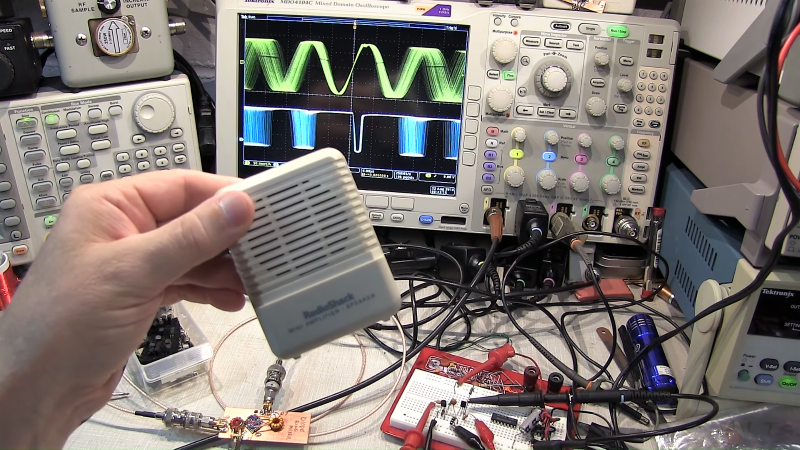Compared to the simple diode needed to demodulate AM radio signals, the detector circuits used for FM are slightly more complicated. Wrapping your head around phase detectors, ratio detectors, discriminators, and quadrature detectors can be quite an exercise. There’s another demodulation method that’s not so common, but thankfully it’s also pretty easy to understand: the pulse counting detector.
As [Allan (W2AEW)] notes in the video below, pulse counting is a bit of a misnomer. Pulse counting works by generating a narrow, fixed-width square wave pulse at a set point in the received FM signal’s waveform, usually at the zero-crossing point. Since the frequency of the modulated carrier changes, the duty cycle of the resulting pulse train varies. That means there will be a fixed number of pulses, but by taking the average voltage of the pulse train, we can tease out the original audio frequency signal.
Simple in theory is often more complicated in practice, and [W2AEW] goes into some detail about those complications, such as needing to use a down-converter to make the peak-to-peak frequency deviation in the pulse train more easily detectable. As is his style, he walks us through a test circuit to prove that the theory works in practice. A simple two-transistor circuit generates the pulses at the zero-crossing point, a low-pass filter cleans up the signal, and a cheap audio amplifier reproduces the original audio. It’s a crude circuit to be sure, relying on the stray capacitance of the breadboard to work, but it proves the point and serves as a jumping-off point for further experiments – perhaps using an Arduino to count the pulses?
We always enjoy [W2AEW]’s videos and learn a lot from them. Not long ago we featured another of his videos talking about the mysteries of RF modulation; SSB, anyone?
















Nice coincidence, was just looking at crafting a dirt cheapest tiniest circuit to detect presence of an FM (fsk 4.5KHz) modulated signal at arbitrary narrow bands +-10KHz resolution around 433MHz or so, thanks for post – this also offered wide ranging exploratory paths, interested in comments too, cheers
Note that this detector does not perform very well for weak signals. Also you don’t get the FM capture effect. Another simple demodulator is using slope detection. It has the advantage or disadvantage that the same circuit also receives AM.
But doesn’t the capture effect come f rom the limiters in an FM receiver, rather than inherent to the FM detector? So much gain and limiting that a strong signal be more potent than a weaker signal, and thus “capture” the receiver.
Hence the implementation sets the tone. There are simple and cheap pulse counting detectors that do little or no limiting, but there were some commercial FM broadcast receivers that were full receivers with pulse counting detectors. There was a Heathkit that ysed a TTL single shot monostable multivibrator. It had to have the capture effect because there had to be enough amplification and limiting to trigger ttl.
I admit that imp!emented badly these won’t work well with weak signals.
As for slope detection, others might like to knkw that jt is just an am detector, bht by tuning the signal so it’s on the slope of the receiver’s selectivity curve, the FM signal varies in amplitude with tye devjatiin if tge signal, and thus the am detector sees an amplitude variation. By defintion you lose tge capture effect, since limiters woukd strip out any amplitude variation.
Michael
This type of detector has been used with analog FM land mobile radios successfully. Sufficient IF gain and limiting will provide FM Capture. It just works.
The description here seems a bit off. You generate fixed length pulses, but as t he incoming signal varies in frequency t he number of pulses in a guven time increase or decrease. An RC network converts these pulses to a varying DC, representing the incoming signal.
Michael
Heathkit had an FM receiver they claimed was “better” using this technique.
Look at his documentation style. Look at that handwriting! And he even uses a rat shack amplified speaker.
I’m convinced.
Allan Wolke and Forrest M Mimms III are 2 avatars of the same soul.